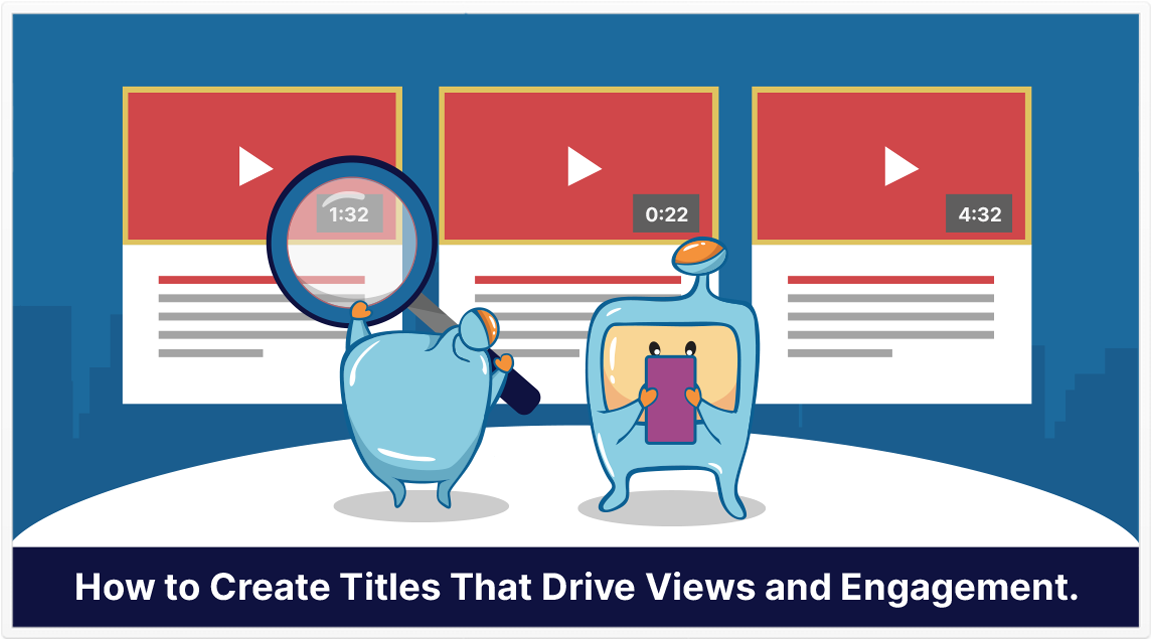In the vast ocean of online content, a captivating video title can be the difference between a viewer clicking to watch your video or scrolling past it.
Crafting effective YouTube titles requires a blend of creativity, strategic keyword placement, and an understanding of your target audience.
In this comprehensive guide, we'll delve into the art and science of creating compelling video titles that grab attention, boost visibility, and drive engagement on YouTube.

Here is what you will read in this article:

The importance of YouTube video titles cannot be overstated.
They serve as the first impression viewers have of your content and play a crucial role in determining whether someone clicks on your video or scrolls past it.
Here are several key reasons why YouTube video titles are of utmost importance:
Grabbing Attention: In a sea of countless videos, a well-crafted title can grab the attention of viewers and entice them to click.
It is your opportunity to make a strong first impression and stand out from the competition.
A compelling title can pique curiosity, evoke emotions, or promise valuable information, making viewers more inclined to watch your video.
Search Engine Optimization (SEO): YouTube is a search engine, and optimizing your video titles is essential for ranking higher in search results.
By strategically incorporating relevant keywords into your titles, you increase the chances of your video appearing when users search for related content.
Effective keyword usage helps you reach your target audience and attract organic traffic to your videos.
Click-Through Rate (CTR): YouTube considers the CTR of a video when determining its overall performance.
A high CTR indicates that viewers find your title intriguing and are compelled to click and watch your video.
YouTube's algorithm recognizes this engagement and rewards videos with higher CTR by suggesting them to more users.
Crafting a captivating title that encourages clicks can significantly impact your video's visibility and reach.

Viewer Expectations: A well-crafted title sets clear expectations for viewers regarding the content of your video.
It helps them understand what they can expect to see or learn from watching your video.
By accurately representing the topic, genre, or purpose of your content in the title, you attract viewers who are genuinely interested in what you have to offer.
Meeting these expectations enhances viewer satisfaction and encourages engagement.
Social Sharing: An attention-grabbing title can also contribute to the viral potential of your video.
When viewers come across a captivating title, they are more likely to share it with their friends, family, or social media followers.
This word-of-mouth sharing expands your video's reach and exposes it to new audiences, potentially leading to increased views, subscribers, and engagement.

Branding and Consistency: Consistency in your video titles can help establish your brand identity and make it easier for viewers to recognize your content.
Using a consistent format, style, or keyword placement in your titles creates a sense of familiarity and builds trust with your audience.
It helps viewers associate your content with specific themes, topics, or expertise, which can lead to increased loyalty and return viewership.
An effective video title on YouTube is a carefully crafted combination of elements that work together to engage viewers, optimize search visibility, and entice clicks.
Understanding the anatomy of an effective video title can help you create compelling titles that stand out and resonate with your target audience.
Here are the key components:
Relevance is one of the most important factors when creating a video title.
Your title should accurately reflect the content of your video and align with the expectations of your target audience.
It's essential to understand what your viewers are searching for and ensure that your title addresses their needs or interests.
By being relevant, you increase the chances of attracting the right viewers who are genuinely interested in your content.
Keywords are specific words or phrases that users are likely to use when searching for content on YouTube.
Incorporating relevant keywords into your video title can significantly improve your video's visibility in search results.
Conduct thorough keyword research to identify the terms and phrases that are popular and relevant to your video's topic.
Strategically place these keywords in your title to help search engines understand the context of your video and increase its chances of ranking higher in search results.
The length of your video title is an important consideration.
YouTube typically displays the first 60-70 characters of a title in search results, so it's crucial to make those characters count.
Keep your title concise, informative, and captivating within this character limit.
A shorter title often grabs attention more effectively and is easier to read and comprehend.
However, make sure the title still conveys the essence of your video and entices viewers to click.

Emotional appeal can be a powerful tool in capturing viewers' attention and generating interest in your video.
Incorporating emotional triggers or appealing to the emotions of your audience can make your video title more compelling.
Depending on the nature of your content, you can evoke emotions like curiosity, excitement, inspiration, or empathy.
Emotionally charged titles have the potential to stand out in a sea of other videos and create a stronger connection with your viewers.
By incorporating these key elements into your video titles, you can create titles that are relevant, optimized for search, and engaging to your target audience.
Remember to strike a balance between incorporating keywords and creating titles that are captivating, accurate, and representative of your video content.
Continuously monitor the performance of your titles and make adjustments based on viewer feedback and analytics data to optimize your title strategies over time.
Keyword research is a critical aspect of creating effective video titles on YouTube.
It involves identifying the most relevant and popular keywords or search terms that users are likely to use when searching for videos in your niche.
By conducting thorough keyword research, you can optimize your video titles to improve visibility, reach your target audience, and ultimately drive more views and engagement.
Here's an expanded look at the process of keyword research for video titles:
Before diving into keyword research, it's essential to have a clear understanding of your target audience.
Consider their demographics, interests, and the specific topics they are searching for.
Put yourself in their shoes and think about the words or phrases they would use when looking for content similar to yours.

Start by brainstorming a list of broad topics related to your video content.
These topics should align with your channel's niche and target audience.
Think about the main themes or subjects that your viewers would be interested in.
This step will help you generate a foundation for your keyword research.
Utilize keyword research tools to expand your list of relevant keywords.
Tools like Google Keyword Planner, SEMrush, Ahrefs, and TubeBuddy provide insights into search volumes, competition, and related keywords.
Enter your broad topics into these tools, and they will generate a list of keyword suggestions based on search volume and relevance.
Pay attention to long-tail keywords (phrases with three or more words) as they often have less competition and more specific intent.
Evaluate the competition and search volume associated with each keyword.
High competition means it may be challenging to rank for that keyword, while low competition presents an opportunity to stand out.
Look for keywords with a balance of decent search volume and manageable competition.
Focus on keywords that are highly relevant to your video content and have the potential to attract your target audience.
When selecting keywords, consider the user intent behind those keywords.
Are users looking for informational content, tutorials, product reviews, or entertainment? Understanding user intent will help you create video titles that align with what viewers are seeking.
Tailor your titles to fulfill the specific needs or desires of your target audience.
Once you've identified a set of relevant keywords, strategically incorporate them into your video titles.
Aim to use the primary keyword in the beginning or near the beginning of the title to maximize its impact.
However, prioritize creating engaging and compelling titles that capture viewers' attention while still including your target keywords.

Keep a close eye on the performance of your video titles and monitor how they rank in search results.
Analyze the viewership, click-through rates, and engagement metrics for each video to determine the effectiveness of your chosen keywords.
If you notice certain keywords underperforming, consider making adjustments or experimenting with alternative keywords to optimize your titles further.
Writing compelling video titles is crucial for capturing the attention of viewers and enticing them to click on your videos.
An effective video title can make a significant difference in the success of your YouTube channel.
Striking a balance between creativity and clarity is key; craft titles that accurately represent your content while capturing the interest of viewers.
While it's important to create compelling titles, avoid using clickbait or misleading tactics that may harm your channel's reputation.
Once you've created your video titles, it's essential to test and optimize them for maximum impact.
A/B testing can help you compare different variations of titles to determine which ones perform better in terms of click-through rates and viewer engagement.
Additionally, monitoring metrics such as watch time, audience retention, and viewer feedback can provide valuable insights into the effectiveness of your titles.

When it comes to crafting YouTube titles, following these best practices can greatly enhance the effectiveness and impact of your videos:
A compelling video title should clearly convey the topic or main idea of your video in a concise manner.
Avoid vague or misleading titles that may confuse viewers.
Instead, use descriptive language that accurately represents the content and purpose of your video.
This clarity helps potential viewers understand what they can expect from your video and increases the likelihood of them clicking on it.
Keywords play a crucial role in YouTube SEO (Search Engine Optimization).
Conduct thorough keyword research to identify relevant terms and phrases that are commonly searched for in your niche.
Incorporate these keywords naturally into your title to help search engines understand the content of your video and improve its visibility in search results.
Your video title should also pique the curiosity of viewers and create a sense of intrigue.
Consider using attention-grabbing words, phrases, or questions that spark interest and make viewers curious to learn more.
Some examples are: "unbelievable," "secret," "revealed," or "mind-blowing."
By sparking curiosity, you can generate interest and compel viewers to click on your video to satisfy their curiosity.
Emotions play a powerful role in capturing and retaining viewers' attention.
Including emotional appeal in your video titles can help create a stronger connection with your audience.
Think about the emotions that your video content evokes, such as excitement, inspiration, humor, or surprise.
Incorporate words or phrases that convey those emotions to make your title more compelling.
Powerful words can have a significant impact on the attractiveness of your video titles.
Power words are persuasive and evoke strong emotions or reactions.
Examples of power words include: "ultimate," "essential," "guaranteed," "revolutionary," "exclusive," or "proven."
These words add a sense of value, urgency, or authority to your titles, making them more enticing to potential viewers.
Consider search engine optimization (SEO) when crafting your titles.
Ensure that your titles align with popular search queries related to your video's topic.
Additionally, YouTube's suggested videos feature recommends related content to viewers.
By including relevant keywords and creating titles that align with similar videos, you increase the chances of your video being suggested alongside popular content.

While it's important to create engaging titles, it's crucial to avoid clickbait.
Clickbait titles may initially attract clicks, but if they don't deliver on the promised content, viewers may feel deceived and lose trust in your channel.
Maintain transparency and ensure that your title accurately represents the actual content of your video.
It's essential to test different variations of titles and analyze their performance to see what resonates best with your audience.
Pay attention to metrics like click-through rates, audience retention, and engagement to determine which titles are most effective.
Based on the data, refine and optimize your titles over time to maximize their impact on resonating with your audience and helping guide future title optimizations.
Develop a consistent style and tone in your titles that aligns with your brand and content.
Consistency helps viewers recognize your videos and builds a sense of trust and familiarity with your channel.
Whether you prefer informative, humorous, or provocative titles, ensure they accurately represent your video's content and resonate with your target audience.
Building authenticity and trust through consistent branding helps you establish a loyal viewer base.
Including numbers in your video titles can make them more appealing and clickable.
Numbers provide structure and indicate that viewers will receive specific, actionable information or a curated list of tips.
For example, titles like "5 Proven Strategies for Success" or "10 Must-Try Recipes" can attract attention and indicate the value viewers can expect from your content.
Consider your target audience's interests, preferences, and needs when crafting video titles.
Use language and terminology that resonates with your specific audience.
Understanding their pain points, aspirations, or desires will allow you to create titles that speak directly to them and highlight the benefits or solutions your video offers.
A cohesive relationship between video titles and thumbnails is crucial for capturing viewers' attention.
The combination of an intriguing title and a visually appealing thumbnail creates a compelling narrative and entices viewers to click.
Creators should ensure that their titles and thumbnails work harmoniously to deliver a consistent message and enhance the overall visual appeal.
Crafting compelling video titles is a vital skill for any YouTube creator.
YouTube video titles hold tremendous power in capturing viewers' attention, optimizing search rankings, and increasing engagement.
Remember to stay creative, stay relevant, and always strive to connect with your target audience through captivating video titles.